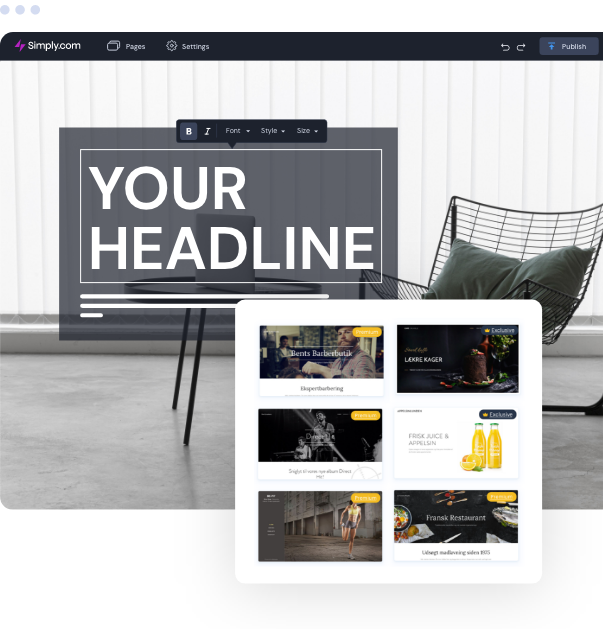Vital Elements of Reliable Web Site Layout: A Comprehensive Guide
In the world of electronic presence, reliable web site style is essential to achieving both customer complete satisfaction and service purposes. The duty of aesthetic pecking order and top quality content can not be taken too lightly, as they considerably influence individual communications and perceptions.
User-Centric Style Concepts
User-centric design concepts develop the foundation of efficient internet site layout, prioritizing the needs and experiences of completion individual. These principles are rooted in understanding customer actions, choices, and difficulties, guaranteeing that the internet site serves its designated audience effectively.
At the heart of user-centric style is compassion. Developers should participate in extensive user study, employing techniques such as surveys, interviews, and use testing to gather insights right into user expectations. website design in singapore. This info notifies design choices, resulting in intuitive navigating, clear info architecture, and involving visuals
An additional trick facet is access. An internet site must be useful for individuals with varying capacities, sticking to well established standards and standards. This commitment not only enhances individual experience but additionally broadens the possible audience.
In addition, repetitive layout is necessary. By continually checking and improving the web site based on user responses, developers can adapt to developing demands, making sure the website stays relevant and reliable. In recap, user-centric style concepts cultivate a deep understanding of completion individual, causing a more appealing, easily accessible, and inevitably effective site. This fundamental strategy lays the foundation for all subsequent design considerations.
Importance of Responsive Layout
A responsive format is essential in today's digital landscape, where a considerable part of internet website traffic originates from mobile phones. As customers accessibility sites on a range of screen sizes, from smartphones to tablets and bigger displays, ensuring that a web site adapts flawlessly to these different dimensions is vital for keeping usability and interaction.

Additionally, a responsive format minimizes the requirement for several variations of a site, simplifying upkeep and reducing growth costs. Rather than producing different desktop computer and mobile websites, a solitary responsive style can fit all customers, improving updates and content management.
Inevitably, the relevance of a responsive design can not be overstated; it is an essential part of effective site style that guarantees accessibility, enhances customer contentment, and supports general business objectives in an increasingly mobile-driven globe.
Visual Hierarchy and Aesthetics
3 crucial aspects-- aesthetic power structure, aesthetic appeals, and functionality-- play a pivotal function in efficient site design. Aesthetic pecking order refers to the plan and discussion of components on a webpage to direct customers' focus and focus on details. By using dimension, shade, comparison, and spacing tactically, designers can make certain that one of the most important content attracts attention, resulting in click to find out more improved user engagement and understanding.
Appearances, on the various other hand, includes the general aesthetic charm of the web site. A natural shade palette, unified typography, and appropriate images add to a pleasing layout that resonates with the target audience. An aesthetically enticing website cultivates depend on and credibility, urging users to check out better.
Moreover, aesthetic pecking order and aesthetics must work in tandem with functionality to produce an efficient user experience. Balancing these aspects makes certain that users can navigate the site intuitively while taking pleasure in an interesting aesthetic experience.
Smooth Navigation Techniques
An effective web site style not only astounds users aesthetically but likewise helps with smooth navigating, which is crucial for preserving user interaction. A well-structured navigating system allows individuals to discover details promptly and effectively, improving their general experience.
To attain smooth navigation, prioritize a clear and intuitive menu format. Utilize descriptive tags for food selection items, making certain that individuals can conveniently additional resources understand the web content they will run into. Furthermore, think about carrying out a breadcrumb route. This function enables customers to track their place within the internet site, permitting them to browse back to previous sections effortlessly.
In addition, employ a search feature that is plainly placed and simple to make use of, giving individuals the capacity to locate certain web content without comprehensive surfing. It is additionally important to keep consistency across all pages; comparable navigating elements ought to show up throughout the website to avoid confusion.
Finally, make sure that your navigating is responsive, adapting perfectly to different tools and display dimensions. A mobile-friendly design is increasingly crucial as even more customers blog accessibility websites on smartphones and tablets. By integrating these techniques, you can produce a straightforward navigating experience that urges expedition and lowers bounce prices.
Maximizing Web Content for Engagement
Effective content optimization is important for capturing and maintaining user engagement on a website. Premium material ought to resonate with the target audience while being structured in a way that enhances readability. Making use of headers, bullet factors, and succinct paragraphs enables individuals to rapidly scan the content, promoting a far better understanding of the product.
Including appropriate key words normally into the message not only improves internet search engine exposure but likewise enhances customer experience. Engaging multimedia components, such as images, video clips, and infographics, can separate textual uniformity and provide aesthetic context, making the content extra appealing.
An additional vital facet is the call to activity (CTA), which should be clear and engaging, guiding individuals in the direction of desired communications. Utilizing A/B testing can help in figuring out which material styles or messaging designs resonate most with the audience.

Conclusion
To conclude, efficient site layout is essentially rooted in user-centric concepts, responsive layouts, aesthetic hierarchy, smooth navigation, and appealing content optimization. These crucial aspects operate in tandem to enhance customer experience and foster meaningful communications. By prioritizing these elements, websites can accomplish greater availability and satisfaction, eventually leading to enhanced involvement and retention rates. A detailed understanding and implementation of these principles are critical for establishing an effective on-line presence in a progressively electronic landscape.